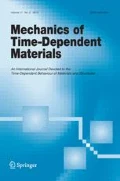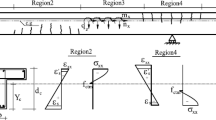Abstract
An improved analytical model based on rheological-dynamical analogy (RDA) is briefly explained and used for the analysis of concrete cylinders under compression. The approach involves standard mechanical properties such as compressive strength, elastic modulus, concrete density and Poisson’s ratio for the prediction of both the ascending and the descending branch of the stress–strain curve. Our own experimental data for arbitrarily selected high strength concrete with high deformability was analyzed. Further, the validity of the RDA model is checked against tests of other authors for one normal concrete and for six recycled aggregate concrete mixtures. To demonstrate the capabilities of the improved model, using analytically established stress–strain relations for analyzed samples, the moment-curvature relations and ductility of reinforced concrete beams in bending were numerically examined. The analysis showed that the ductile behavior of beams made of concrete with recycled aggregate can be achieved by limiting the reinforcement ratio to 0.01 if the recycled concrete aggregate is used and to 0.02 for recycled brick aggregate.













Similar content being viewed by others
Data availability
Not applicable
Code availability
Not applicable
References
Ajdukiewicz, A., Kliszczewicz, A.: Influence of recycled aggregates on mechanical properties of HS/HPC. Cem. Concr. Compos. 24, 269–279 (2002)
Ajdukiewicz, A., Kliszczewicz, A.: Comparative tests of beams and columns made of recycled aggregate concrete and natural aggregate concrete. J. Adv. Concr. Technol. 5(2), 259–273 (2007)
Breccolotti, M., D’Alessandro, A., Roscini, F., Bonfigli, M.F.: Investigation of stress–strain behavior of recycled aggregate concrete under cyclic loads. Environ. Eng. Manag. J. 14(7), 1543–1552 (2015)
Carpinteri, A., Corrado, M., Paggi, M.: An analytical model based on strain localization for the study of size-scale and slenderness effects in uniaxial compression tests. Strain 47, 351–362 (2011)
Chen, X., Wu, S., Zhou, J.: Experimental study and analytical formulation of mechanical behavior of concrete. Constr. Build. Mater. 47, 662–670 (2013)
EN 1992-1-1: Eurocode 2: Design of concrete structures. Part 1-1: general rules and rules for buildings. CEN, Brussels (2004)
González-Fonteboa, B., Martínez-Abella, F., Carro López, D., Seara-Paz, S.: Stress-strain relationship in axial compression for concrete using recycled saturated coarse aggregate. Constr. Build. Mater. 25, 2335–2342 (2011)
Hillerborg, A., Modeer, M., Petersson, P.E.: Analysis of crack formation and crack growth in concrete by means of fracture mechanics and finite elements. Cem. Concr. Res. 6(6), 773–781 (1976)
Ignjatović, I.: Ultimate strength of reinforced recycled concrete beams. PhD thesis, University of Belgrade, Belgrade (2013)
Ignjatović, I.S., Marinković, S.B., Mišković, Z.M., Savić, A.R.: Flexural behavior of reinforced recycled aggregate concrete beams under short-term loading. Mater. Struct. 46(6), 1045–1059 (2013)
Kotsovos, M.D.: Effect of testing techniques on the post-ultimate behavior of concrete in compression. Mater. Struct. 16(91), 3–12 (1983)
Lemaitre, J.: How to use damage mechanics. Nucl. Eng. Des. 80, 233–245 (1984)
Luo, S., Ye, S., Xiao, J., Zheng, J., Zhu, Y.: Carbonated recycled coarse aggregate and uniaxial compressive stress–strain relation of recycled aggregate concrete. Constr. Build. Mater. 188, 956–965 (2018)
Milašinović, D.D.: Rheological-dynamical analogy: modeling of fatigue behavior. Int. J. Solids Struct. 40(1), 181–217 (2003)
Milašinović, D.D.: Rheological-dynamical analogy: design of viscoelastic and viscoplastic bar dampers. Mech. Time-Depend. Mater. 14(4), 389–409 (2010)
Milašinović, D.D.: Rheological-dynamical continuum damage model for concrete under uniaxial compression and its experimental verification. Theor. Appl. Mech. 42(2), 73–110 (2015)
Milašinović, D.D.: Rheological-dynamical analogy for analysis of low cycle fatigue in seismically isolated regular bridges. Eng. Struct. 191, 493–508 (2019)
Milašinović, D.D., Goleš, D., Čeh, A.: Rheological-dynamical continuum damage model applied to research of the rotational capacity of a reinforced concrete beams. Period. Polytech., Civ. Eng. 60(4), 661–667 (2016)
Milašinović, D.D., Marić, P., Živanov, Ž., Hajduković, M.: Inelastic buckling mode interactions and resonance instabilities in thin-walled columns due to the fatigue damage. Eng. Comput. 37(8), 2819–2845 (2020)
Müller, C.: Beton als kreislaufgerechter Baustoff. Schriftenreihe des Deutschen Ausschuss für Stahlbeton DafStb, vol. 513. Beuth, Berlin (2001)
Murakami, S.: Continuum Damage Mechanics. Springer, Berlin (2012)
Nobis, Ch., Vollpracht, A.: Verwendung von Recyclingmaterial in der Betonproduktion – Sachstand – Forschungsbericht F-7099. Institut für Bauforschung, Aachen (2015)
Pann, K.S., Yen, T., Tang, C.-W., Lin, T.D.: New strength model based on water-cement ratio and capillary porosity. ACI Mater. J. 4, 311–318 (2003)
Peng, J.L., Du, T., Zhao, T.S., Song, X., Tang, J.J.: Stress–strain relationship model of recycled concrete based on strength and replacement rate of recycled coarse aggregate. J. Mater. Civ. Eng. 31(9), 04019189 (2019)
Pradhan, S., Kumar, S., Barai, S.V.: Performance of reinforced recycled aggregate concrete beams in flexure: experimental and critical comparative analysis. Mater. Struct. 51, 58 (2018)
Silva, R.V., de Brito, J., Evangelista, L., Dhir, R.K.: Design of reinforced recycled aggregate concrete elements in conformity with Eurocode 2. Constr. Build. Mater. 105, 144–156 (2016)
Tschoegl, N.W., Wolfgang Knauss, G., Emri, I.: Poisson’s ratio in linear viscoelasticity – a critical review. Mech. Time-Depend. Mater. 6, 3–51 (2002)
Van Mier, J.G.M., Shah, S.P., Arnaud, M., Balayssac, J.P., Bascoul, A., Choi, S., et al.: Strain-softening of concrete in uniaxial compression. Mater. Struct. 30(4), 195–209 (1997)
Xiao, J., Li, J., Zhang, C.: Mechanical properties of recycled aggregate concrete under uniaxial loading. Cem. Concr. Res. 35(6), 1187–1194 (2005)
Xiao, J., Zhang, K., Akbarnezhad, A.: Variability of stress–strain relationship for recycled aggregate concrete under uniaxial compression loading. J. Clean. Prod. 181, 753–771 (2018)
Acknowledgements
The support of the Ministry of Science and Technology, Republic of Serbia is gratefully acknowledged.
Funding
The work presented in this paper is a part of the investigation conducted within the research projects ON 174027 “Computational Mechanics in Structural Engineering” and TR 36017 “Utilization of by-products and recycled waste materials in concrete composites for sustainable construction development in Serbia: investigation and environmental assessment of possible applications”, supported by the Ministry of Science and Technology, Republic of Serbia.
Author information
Authors and Affiliations
Corresponding author
Ethics declarations
Conflicts of interest/Competing interests
Not applicable
Additional information
Publisher’s Note
Springer Nature remains neutral with regard to jurisdictional claims in published maps and institutional affiliations.
Rights and permissions
About this article
Cite this article
Milašinović, D.D., Goleš, D., Pančić, A. et al. Rheological-dynamical model of concrete and its application on RC beams. Mech Time-Depend Mater 26, 79–99 (2022). https://doi.org/10.1007/s11043-020-09476-8
Received:
Accepted:
Published:
Issue Date:
DOI: https://doi.org/10.1007/s11043-020-09476-8




